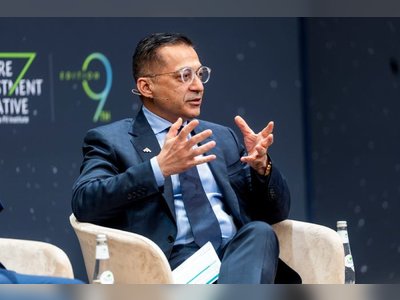
The CDC is beholden to corporations and lost our trust. We need to start our own
We’re epidemiologists, nurses and physicians, artists and biologists. We have come together with a common anger at the US government’s handling of Covid
A new omicron variant, referred to as BA 2, is taking hold in the US. Anthony Fauci and others have said they don’t expect a new surge in the US, but BA.2 is causing devastating surges elsewhere, and the policies and behaviors we might use to prevent a surge in the US have been widely abandoned, in part thanks to the CDC’s new system for measuring and conveying Covid risk.
In late February, the US Centers for Disease Control and Prevention (CDC) unveiled a new Covid-19 monitoring system based on what they call “Community Levels.” By downplaying the importance of Sars-CoV-2 transmission, the new system instantly turned what was a pandemic map still red from Omicron transmission to green – creating the false impression that the pandemic is over.
Released four days before the State of the Union, the new CDC measures and the narrative they created let President Biden claim victory over the virus via sleight of hand: a switch from standard reporting of community transmissions to measures of risk based largely on contentious hospital-based metrics. The previous guidelines called anything over 50 cases per 100,000 people “substantial or high.” Now, they say 200 cases per 100,000 is “low” as long as hospitalizations are also low.
The resulting shift from a red map to a green one reflected no real reduction in transmission risk. It was a resort to rhetoric: an effort to craft a success story that would explain away hundreds of thousands of preventable deaths and the continued threat the virus poses.
These new guidelines are at odds with evidence-based and equitable public health practice in three fundamental ways.
First, they do not intend to prevent disease spread. By minimizing the importance of new cases, and focusing instead on hospitalizations–a lagging indicator–the revamped warning system delays action until surges are well underway and the consequences of severe disease and death are already in motion. Making matters worse, at-home tests are not recorded in the US, so the only “early indicator” in the risk level calculation grossly undercounts the true number of cases.
The justification for the shift is that the virus is mostly harmless– a claim which not only ignores that one million have already died in the US alone, but also completely erases the reality of Long Covid. Studies indicate that 10-30% of Covid infections deteriorate into multiple debilitating syndromes lasting months to years. Minimizing Covid’s risks to the public will only increase these harms in our communities.
Secondly, the new guidelines do more than inappropriately message safety; the guidelines shift the burden of responsibility onto vulnerable people. In place of clear, evidence-based guidance on masking for those facing greater risk, for example, the CDC simply advises individuals to consult with their local healthcare provider. This instruction assumes that providers are accessible, well informed, and willing to take on the personal liability for giving guidance around a potentially fatal virus that the CDC was once responsible for. In a country without healthcare for all, these assumptions are wrong.
Even before these changes, Biden and the CDC declared the US faced a “pandemic of the unvaccinated” – disregarding the risks faced by those of us living with chronic diseases and disabilities, including the immunocompromised; those with lower incomes and higher-risk jobs; members of indigenous, Black, and Latinx communities; the elderly; the pregnant; and children, especially under five years old.
These vulnerable populations have unjustly had too little access to vaccines, masks, testing, and clean air. Many faced employment practices forcing them into unsafe, in-person work, while those more privileged protected themselves by working and learning remotely. We’ve already seen the consequences of these inequities: disproportionate death and disability in structurally vulnerable communities. Now, by increasing transmissions, inequities will continue to multiply as the pandemic continues.
Thirdly, the guidelines are blatantly political. The new recommendations aim to convince the public that this pandemic is over when it is not. They suggest we tolerate the nearly one million US dead, and too-quickly abandon measures that would keep that number from growing. They suggest we continue to isolate those with chronic illness and disability while the rest return to “normal” life. They suggest Long Covid isn’t the rapidly growing crisis that it is, especially for those fully vaccinated, despite documented risks of ongoing and sometimes disabling symptoms. They dismiss the near-inevitable emergence of new variants. They dismiss the urgency to vaccinate the rest of the world.
Before the new CDC guidelines, the vulnerable were moderately protected by local mask mandates, passing shelter-in-place recommendations, and general support for public health interventions aimed at collective well-being. There was at least some urgency around vaccination campaigns and occupational protections against the virus. There was recognition that Covid was still a threat.
Changing the metrics alone permitted jurisdictions across the US to retire mask mandates and people to retire their masks. As successful health campaigns are interrelated, efforts to vaccinate against Covid and improve ventilation in schools and at work have also lost steam. The shift from red to green reflects both major US parties turning the page on the virus as a political problem rather than a change in the reality of the pandemic. And the red to green shift also paved the way for the political class to wash their hands of would-be fights over Covid funding.
Some claim that the White House and the CDC are “following the science” and doing the best they can in these times. But if the goal is to prevent infection and suffering, the updated recommendations do not align with science or equity. It’s more accurate to say they’re following the money. They’ve put the desires of corporate America above the needs of our people, and especially our most vulnerable.
We need a CDC that prioritizes the health of the people, not the health of big business. We need a People’s CDC. And so we formed one.
We’re epidemiologists and physicians, artists and biologists. We’re children, parents, and grandparents. We’re living with Long Covid and losses of loved ones. We’ve come together with a common anger at our government’s disregard for social and public health responsibilities. Though many of us have just met, we inherit hundreds of years of resistance traditions.
We greet this work with humility, recognizing there are still many uncertainties about new variants, Long Covid, and the future of therapeutics. Yet we know enough to reject, with certainty, ineffectual public health policies based on individualistic approaches. And we are certain that there is another way - that collective action has always and can now create a new way forward in responding to Covid and other deadly pathogens.
We’ve already put out a statement and recommendations about BA 2, a statement regarding the CDC’s new recommendations and we brought together a coalition of groups to create an equity-focused toolkit to help parents and teachers demand the best Covid protections in schools. We are in the midst of developing COVID “weather reports” on the state of the pandemic based on epidemiological data rather than what corporate America demands.
We demand a layered, collective, and equitable approach to the pandemic. We recognize that none are safe from contagious disease until we are all safe. It is with this understanding that we will continue to share the latest on the state of the pandemic, toolkits for action, and recommendations on what to do, developed for and together with community organizations. For it is only through collective power that we can create a new, more equitable world that can not only control outbreaks but also prevent them from emerging in the first place.
We hope you will join us.
Mindy Fullilove, MD, The New School
Zoey Thill, MD, MPH, MPP, Family Medicine Physician
Josh Garoon, PhD, University of Wisconsin-Madison
Mary Jirmanus Saba, Independent Filmmaker
Lucky Tran, PhD, March for Science
Elaine A. Hills, PhD, Independent Public Health Scientist
Jeoffry B. Gordon, MD, MPH, California Physicians Alliance
Douglas Farrand, University of Orange
Dannie Ritchie, MD, MPH, Brown University, Community Health Innovations of Rhode Island
Kaliris Y. Salas-Ramirez, PhD, The City College of New York
Sam Friedman, PhD, NYU Grossman School of Medicine
Molly Rose Kaufman, University of Orange
Daniel Joseph Wiley, The HUUB
Robert G. Wallace, PhD, Pandemic Research for the People
Margeaux Simmons, PhD, University of Orange
Edgar Rivera Colon, PhD, USC Keck School of Medicine
In late February, the US Centers for Disease Control and Prevention (CDC) unveiled a new Covid-19 monitoring system based on what they call “Community Levels.” By downplaying the importance of Sars-CoV-2 transmission, the new system instantly turned what was a pandemic map still red from Omicron transmission to green – creating the false impression that the pandemic is over.
Released four days before the State of the Union, the new CDC measures and the narrative they created let President Biden claim victory over the virus via sleight of hand: a switch from standard reporting of community transmissions to measures of risk based largely on contentious hospital-based metrics. The previous guidelines called anything over 50 cases per 100,000 people “substantial or high.” Now, they say 200 cases per 100,000 is “low” as long as hospitalizations are also low.
The resulting shift from a red map to a green one reflected no real reduction in transmission risk. It was a resort to rhetoric: an effort to craft a success story that would explain away hundreds of thousands of preventable deaths and the continued threat the virus poses.
These new guidelines are at odds with evidence-based and equitable public health practice in three fundamental ways.
First, they do not intend to prevent disease spread. By minimizing the importance of new cases, and focusing instead on hospitalizations–a lagging indicator–the revamped warning system delays action until surges are well underway and the consequences of severe disease and death are already in motion. Making matters worse, at-home tests are not recorded in the US, so the only “early indicator” in the risk level calculation grossly undercounts the true number of cases.
The justification for the shift is that the virus is mostly harmless– a claim which not only ignores that one million have already died in the US alone, but also completely erases the reality of Long Covid. Studies indicate that 10-30% of Covid infections deteriorate into multiple debilitating syndromes lasting months to years. Minimizing Covid’s risks to the public will only increase these harms in our communities.
Secondly, the new guidelines do more than inappropriately message safety; the guidelines shift the burden of responsibility onto vulnerable people. In place of clear, evidence-based guidance on masking for those facing greater risk, for example, the CDC simply advises individuals to consult with their local healthcare provider. This instruction assumes that providers are accessible, well informed, and willing to take on the personal liability for giving guidance around a potentially fatal virus that the CDC was once responsible for. In a country without healthcare for all, these assumptions are wrong.
Even before these changes, Biden and the CDC declared the US faced a “pandemic of the unvaccinated” – disregarding the risks faced by those of us living with chronic diseases and disabilities, including the immunocompromised; those with lower incomes and higher-risk jobs; members of indigenous, Black, and Latinx communities; the elderly; the pregnant; and children, especially under five years old.
These vulnerable populations have unjustly had too little access to vaccines, masks, testing, and clean air. Many faced employment practices forcing them into unsafe, in-person work, while those more privileged protected themselves by working and learning remotely. We’ve already seen the consequences of these inequities: disproportionate death and disability in structurally vulnerable communities. Now, by increasing transmissions, inequities will continue to multiply as the pandemic continues.
Thirdly, the guidelines are blatantly political. The new recommendations aim to convince the public that this pandemic is over when it is not. They suggest we tolerate the nearly one million US dead, and too-quickly abandon measures that would keep that number from growing. They suggest we continue to isolate those with chronic illness and disability while the rest return to “normal” life. They suggest Long Covid isn’t the rapidly growing crisis that it is, especially for those fully vaccinated, despite documented risks of ongoing and sometimes disabling symptoms. They dismiss the near-inevitable emergence of new variants. They dismiss the urgency to vaccinate the rest of the world.
Before the new CDC guidelines, the vulnerable were moderately protected by local mask mandates, passing shelter-in-place recommendations, and general support for public health interventions aimed at collective well-being. There was at least some urgency around vaccination campaigns and occupational protections against the virus. There was recognition that Covid was still a threat.
Changing the metrics alone permitted jurisdictions across the US to retire mask mandates and people to retire their masks. As successful health campaigns are interrelated, efforts to vaccinate against Covid and improve ventilation in schools and at work have also lost steam. The shift from red to green reflects both major US parties turning the page on the virus as a political problem rather than a change in the reality of the pandemic. And the red to green shift also paved the way for the political class to wash their hands of would-be fights over Covid funding.
Some claim that the White House and the CDC are “following the science” and doing the best they can in these times. But if the goal is to prevent infection and suffering, the updated recommendations do not align with science or equity. It’s more accurate to say they’re following the money. They’ve put the desires of corporate America above the needs of our people, and especially our most vulnerable.
We need a CDC that prioritizes the health of the people, not the health of big business. We need a People’s CDC. And so we formed one.
We’re epidemiologists and physicians, artists and biologists. We’re children, parents, and grandparents. We’re living with Long Covid and losses of loved ones. We’ve come together with a common anger at our government’s disregard for social and public health responsibilities. Though many of us have just met, we inherit hundreds of years of resistance traditions.
We greet this work with humility, recognizing there are still many uncertainties about new variants, Long Covid, and the future of therapeutics. Yet we know enough to reject, with certainty, ineffectual public health policies based on individualistic approaches. And we are certain that there is another way - that collective action has always and can now create a new way forward in responding to Covid and other deadly pathogens.
We’ve already put out a statement and recommendations about BA 2, a statement regarding the CDC’s new recommendations and we brought together a coalition of groups to create an equity-focused toolkit to help parents and teachers demand the best Covid protections in schools. We are in the midst of developing COVID “weather reports” on the state of the pandemic based on epidemiological data rather than what corporate America demands.
We demand a layered, collective, and equitable approach to the pandemic. We recognize that none are safe from contagious disease until we are all safe. It is with this understanding that we will continue to share the latest on the state of the pandemic, toolkits for action, and recommendations on what to do, developed for and together with community organizations. For it is only through collective power that we can create a new, more equitable world that can not only control outbreaks but also prevent them from emerging in the first place.
We hope you will join us.
Mindy Fullilove, MD, The New School
Zoey Thill, MD, MPH, MPP, Family Medicine Physician
Josh Garoon, PhD, University of Wisconsin-Madison
Mary Jirmanus Saba, Independent Filmmaker
Lucky Tran, PhD, March for Science
Elaine A. Hills, PhD, Independent Public Health Scientist
Jeoffry B. Gordon, MD, MPH, California Physicians Alliance
Douglas Farrand, University of Orange
Dannie Ritchie, MD, MPH, Brown University, Community Health Innovations of Rhode Island
Kaliris Y. Salas-Ramirez, PhD, The City College of New York
Sam Friedman, PhD, NYU Grossman School of Medicine
Molly Rose Kaufman, University of Orange
Daniel Joseph Wiley, The HUUB
Robert G. Wallace, PhD, Pandemic Research for the People
Margeaux Simmons, PhD, University of Orange
Edgar Rivera Colon, PhD, USC Keck School of Medicine











